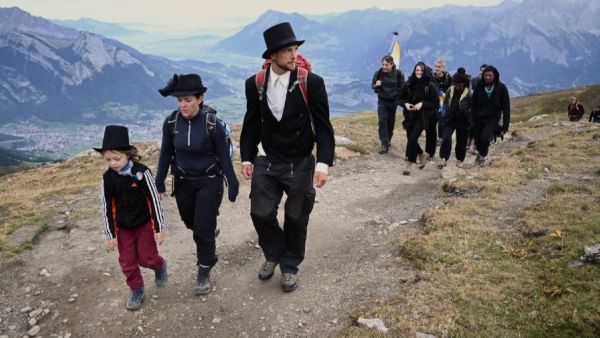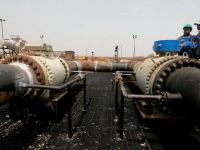Dozens of people dressed in black held a wake today to mark the disappearance of an Alpine glacier, as the UN revealed that the last five years have been the hottest ever globally.
Around 250 people, including children, joined the solemn two-hour climb up the side of Pizol mountain in northeastern Switzerland to the foot of the rapidly melting ice formation.
It is situated at an altitude of around 8,850 feet near the Liechtenstein and Austrian borders.
The 'funeral march' comes as a damning new UN report said that the world is falling badly behind in the race to avert climate disaster as a result of runaway warming.
Swiss glaciologist Matthias Huss said at the glacier today: 'We're here to bid farewell to Pizol.'
Eric Petrini, the chaplain of the Mels municipality where Pizol is located, called on 'God's help to tackle the enormous challenge of climate change'.
The speeches were accompanied by the mournful tones of alphorns - a 12-foot, pipe-shaped wooden instrument.
Some marchers also laid down flowers and flags for the glacier.
Alessandra Degiacomi, of the Swiss Association for Climate Protection, said that Pizol 'has lost so much substance that from a scientific perspective it is no longer a glacier'.
In a study earlier this year, researchers of ETH technical university in Zurich determined that more than 90 per cent of Alpine glaciers will disappear by 2100 if greenhouse gas emissions are left unchecked.
On Monday, there will be a major UN climate summit that will be attended by more than 60 world leaders.
Secretary-General Antonio Guterres will push for countries to increase their greenhouse gas reduction targets.
The UN's report 'highlights the urgent need for the development of concrete actions that halt global warming and the worst effects of climate change,' said its authors, the Science Advisory Group to the summit.
Average global temperature between 2015-2019 is on track to be the hottest of any five-year period on record, according to the report, which was compiled by the World Meteorological Organization.
{"preview_thumbnail":"https://cdn.flowplayer.com/6684a05f-6468-4ecd-87d5-a748773282a3/i/v-i-5…","video_id":"568053db-f56d-4bc8-8871-da0ae05d7131","player_id":"8ca46225-42a2-4245-9c20-7850ae937431","provider":"flowplayer","video":"Mass Anti Sisi Protests Continue for the Second Night in Egypt"}
The period 'is currently estimated to be 1.1 degrees Celsius above pre-industrial (1850-1900) times and 0.2 degrees Celsius warmer than 2011-2015,' it said.
The past four years were already the hottest since record-keeping began in 1850.
Guterres said last week the world was 'losing the race' on climate change, with the latest report spelling out the extent to which the gap between what is required and what is happening is widening.
Rather than falling, carbon dioxide grew two per cent in 2018, reaching a record high of 37 billion tonnes.
More importantly, there is also no sign yet of reaching what is known as 'peak emissions,' the point at which levels will start to fall, though these are not growing at the same rate as the global economy.
The 2015 Paris Agreement saw countries lay out national targets to reduce their emissions in order to limit long term temperature rise by either 2 degrees Celsius or 1.5 degrees Celsius.
These are benchmarks that will limit the impact of warming on world weather systems.
But even if all countries meet the goals they set themselves, the world will warm by 2.9 degrees Celsius to 3.4 degrees Celsius, the report found.
The current levels of ambition would need to be tripled to meet the 2 degrees Celsius goal and increased five-fold to meet the 1.5 degrees Celsius goal - technically still possible.
'This reads like a credit card statement after a 5-year long spending binge,' said Professor Dave Reay, chair in Carbon Management at the University of Edinburgh.
'Our global carbon credit is maxed out,' he added. 'If emissions don't start falling there will be hell to pay.'
In 2018, global carbon dioxide was 407.8 parts per million (ppm), 2.2 ppm higher than 2017 and set to reach or exceed 410 ppm by 2019.
'The last time Earth's atmosphere contained 400 parts per million CO 2 was about 3-5 million years ago,' the report said.
At that time, global mean surface temperatures were 2-3 degrees Celsius warmer, ice sheets at both poles had melted, and seas were 10 to 20 meters higher.
Other major revelations from the report include that the extent of Arctic summer sea ice has declined at a rate of 12 percent per decade over the past 40 years, with the four lowest values between 2015 and 2019.
Overall, the amount of ice lost from the Antarctic ice sheet increased by a factor of six each year between 1979 and 2017, while glacier loss for 2015-19 is also the highest for any five-year period on record.
Sea-level rise is also accelerating as is the process of acidification, with an increase in 26 percent in acidity today compared to pre-industrial periods, as a result of absorbing increased carbon dioxide in the atmosphere.
The report also found that heatwaves were the deadliest weather hazard in the 2015-19 period, affecting all continents and setting new national temperature records.
The summer of 2019, which included the hottest ever month on record, July, saw unprecedented wildfires in the Arctic.
In June, these were responsible for emitting 50 megatons of carbon dioxide.
This article has been adapted from its original source.








